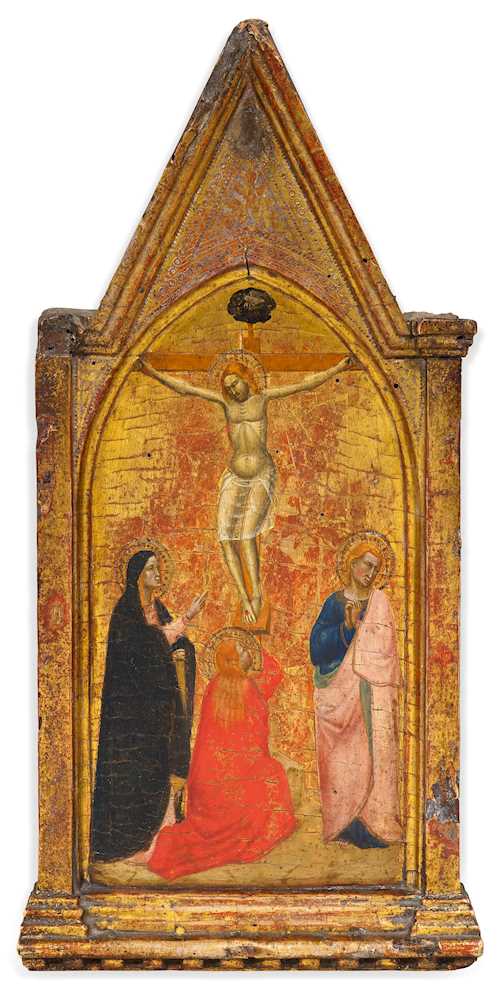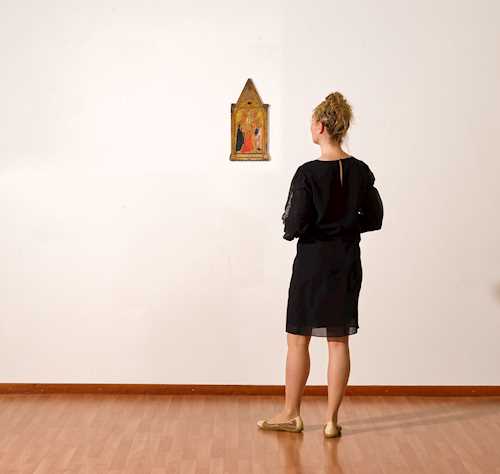
Lot 3004 - A196 Old Master Paintings - Friday, 26. March 2021, 02.00 PM
MAESTRO DELLA MISERICORDIA
Provenance:
Swiss private collection.
This panel depicting the “Crucifixion of Christ” which may once have served as the central panel of a winged altarpiece for private devotions, stands as a fascinating example of Florentine painting after the time of Giotto. It illustrates the moment immediately after the death of Christ the Redeemer. The Holy Magdalene has rushed to the cross, which she embraces fervently. This heightened emotional state is also written on the face of John, to whom Christ shortly before his death, has entrusted the Virgin Mary as her son. The towering slender figure of the Virgin Mary seems composed and has surrendered herself to the fate of God’s Will, while John seems to have sunk into quiet disbelief. Despite the drama evoked by the emotions of the figures, a composed atmosphere of quiet devotion prevails in the picture. The master of this hitherto presumably unpublished panel, has succeeded in incorporating into the picture the artistic achievements of Giotto’s successors.
This is particularly evident if we compare this work with a number of similarly conceived interpretations of the same pictorial theme by Taddeo Gaddi (1290–1366) and Bernardo Daddi (circa 1280–1348), which show quite plainly the kind of artistic environment in which our painter must have moved.
Unmistakable parallels can be found with the works of the Florentine exponent of Giotto’s work, Taddeo Gaddi, not only in the pictorial concept, with the model of Christ hanging on the cross and the Madonna pointing upwards towards him (see Taddeo Gaddi’s "Croce Dipinta" of Montegufoni, circa 1355–60). There are also stylistic similarities in the shaping of the towering slender figures and the morphological articulation of the faces and their extreme foreshortening (see Taddeo Gaddi’s triptych of 1334 in the Berlin State Museum, Inv.-No. 1080 and his "Crucifixion" in der Bristol City Art Gallery, Inv.-No. K2771).
Consequently, this must have been a painter who was familiar with Taddeo Gaddi’s artistic repertoire and who may have been close to the older artist. It is hardly surprising that the panel presented here was, in the early 20th century, still regarded as a work by Taddeo Gaddi, as is inscribed on the back of the panel.
By the same token, the art of our painter exhibits tendencies which indicate an in-depth examination of the late work of Bernardo Daddi. This applies not only to certain motifs which had been handed down, such as the posture of the Magdalene who has rushed to the cross, and her very finely modelled and sharply foreshortened profile (see for example Bernardo Daddi’s "Crucifixion" from 1343 at the Academy in Florence, Inv.-No. 1890/443), but also in the softer modelling of the forms and volumes compared with those of Taddeo Gaddi, as can been seen in Daddi’s late work, which is modelled in a comparable way.
Despite the striking similarities to the above-mentioned works by Taddeo Gaddi and Bernardo Daddi, our painter seems to belong to a later generation. For example, the well-preserved figure of the Magdalene, with her beautiful face modelled in enamel-like layers of paint and the fine strands of blond hair falling over her back, are reminiscent of the Magdalene immersed in pain of the famous "Entombment" by Giotto di Maestro Stefano (called Giottino, circa 1324–1369) in the Uffizi (circa 1357, Inv.-No. 1890/454). This stylistic reference to Giottino also establishes the chronological framework within which the present “Crucifixion” was presumably painted, namely the 6th decade of the 14th century. It is the decade that was marked by the work of Giottino and the Andrea brothers (1308–1368) and Nardo di Cione (circa 1320–1366). It is hardly surprising that one of the “Crucifixions” of Nardo di Cione in the Uffizi (circa 1355–60, Zeri archive No. 3222) of a similar composition to the present panel, was based on older models from earlier generations of painters.
On the basis of a range of similarly configured Crucifixions, Professor Freuler has identified the Master who created this panel with the Maestro della Misericordia, named after a “Virgin of Mercy” at the Academy in Florence (compare for example the “Crucifixion” of the triptych at the Pushkin Museum in Moscow, or a further variant of this pictorial theme, formerly at the collection of Carlo de Carlo in Florence). Based on a stylistic comparison with the panel "The Last Judgement and scenes of the Passion" from the Pinacoteca Nazionale in Bologna, which was produced circa 1355–60 (see Sonia Chiodo: Painters in Florence after the "Black Death": The Master of the Misericordia and Matteo di Pacino, in: A Corpus of Florentine Painting, IV, IX, Florence 2011, p. 139) as well as the panel "Saint Eligius" in the Prado, which can be dated to the 1360s (see Chiodo 2011, p. 150), Professor Freuler dates the present panel to the 1350s and therefore the artist’s early phase, during which his works were still strongly anchored in the art of Taddeo Gaddi and Bernardo Daddi.
For this reason, an early artistic training in the workshop of Taddeo Gaddi should also not be ruled out. This, and the above-mentioned connection to Giottino, as well as what for the 1360s would be a recognisable tendency towards the naturalism of Giovanni da Milano, were used by Miklos Boskovits as an indication that Taddeo Gaddi’s elder son was possibly the figure behind the anonymous Maestro della Misericordia (see Miklos Boskovits: La Pittura Fiorentina alla Vigilia del Rinascimento, Florence 1975, p. 65). Above all, the son, together with Giottino and Giovanni da Milano, is recorded as having been in Rome in 1369, where he is said to have played a leading role within a larger group of painters in the decoration of the renovated Papal Palace for Pope Urban V.
Thus, the present picture of the “Crucifixion” is a new and valuable testimony to the earliest creative phase of the Maestro della Misericordia, marked by the most successful Florentine heirs of Giotto, Taddeo Gaddi and Bernardo Daddi.
Our thanks to Professor Gaudenz Freuler for his assistance in writing this catalogue entry.
CHF 30 000 / 40 000 | (€ 30 930 / 41 240)
Sold for CHF 55 200 (including buyer’s premium)
All information is subject to change.

